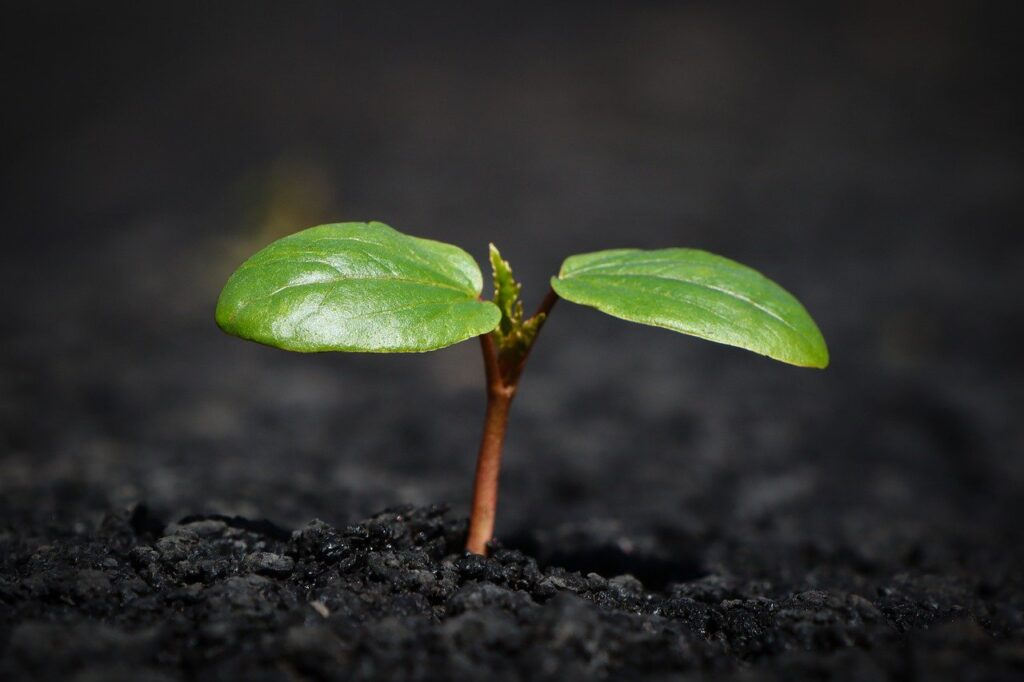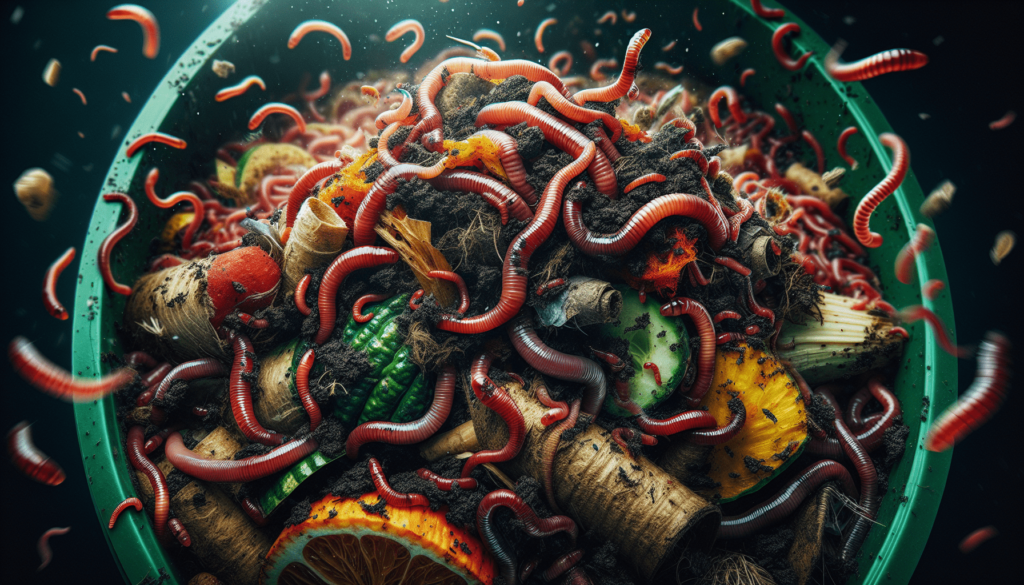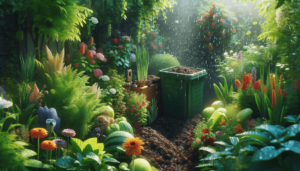Vermicomposting, a fascinating and eco-friendly method of composting, has been gaining popularity among gardening enthusiasts. This intriguing process involves using worms to break down organic waste, transforming it into nutrient-rich soil called vermicompost. Not only does vermiculture provide an efficient way to dispose of kitchen scraps and yard waste, but it also produces a valuable resource for nourishing plants and promoting soil health. If you’re wondering how to get started with vermicomposting, fear not! In this article, we will guide you through the basics of setting up a vermicomposting system and reaping the benefits of this sustainable practice.

What is Vermicomposting
Definition of Vermicomposting
Vermicomposting is a natural and sustainable method of recycling organic waste using worms. It involves the decomposition of organic material such as kitchen scraps, yard waste, and paper with the help of specific types of earthworms, known as red wigglers or Eisenia fetida. These worms break down the waste into nutrient-rich vermicompost, which can be used as a valuable soil amendment for gardens, potted plants, and landscaping.
How Vermicomposting Works
Vermicomposting works through a process called aerobic decomposition. Red wigglers consume organic matter and excrete nutrient-rich castings, which contain beneficial microbes and enzymes that enhance soil health. As the worms digest the waste, moisture and heat are generated within the worm bin. This creates an optimal environment for beneficial bacteria, fungi, and other microorganisms to thrive and accelerate the decomposition process. The end result is a dark, crumbly, and odorless substance called vermicompost, which is a nutrient powerhouse for plants.
Benefits of Vermicomposting
Vermicomposting offers numerous benefits for both the environment and gardeners. Firstly, it reduces the amount of organic waste going to landfills, where it would otherwise contribute to greenhouse gas emissions. Instead, vermicomposting turns waste into a valuable resource that enriches soil and reduces the need for chemical fertilizers. Vermicompost increases soil fertility, improves soil structure, enhances water retention and drainage, promotes healthy root growth, and suppresses plant diseases. Additionally, vermicomposting is a sustainable and low-maintenance method that can be practiced in both indoor and outdoor settings, making it accessible to a wide range of individuals and communities.
Getting Started with Vermicomposting
Choosing the Right Worms
Not all worms are suitable for vermicomposting. The most commonly used species is the red wiggler, or Eisenia fetida. These worms are well-adapted to the vermicomposting process, as they thrive in organic waste and are efficient decomposers. It is important to acquire red wigglers from reputable worm suppliers to ensure their health and suitability for vermiculture.
Selecting a Worm Bin
A worm bin is the container that houses the worms and organic waste during the vermicomposting process. There are various types of worm bins available, including stackable bins, tote bins, and homemade bins. When selecting a worm bin, consider factors such as size, ventilation, drainage, and durability. It is important to choose a bin that accommodates the amount of waste you produce and provides sufficient aeration and moisture control for the worms.
Setting Up the Worm Bin
Proper setup of the worm bin is crucial to create a favorable environment for the worms. Begin by adding a bedding layer, which can consist of shredded newspaper, cardboard, or coconut coir. Dampen the bedding to achieve the ideal moisture level, similar to a wrung-out sponge. Introduce the worms to their new home by gently placing them on top of the bedding. Cover the worms with another layer of bedding to provide darkness and protection. Place a lid on the bin to maintain a stable environment, while also allowing for proper air circulation.
Preparing Bedding Materials
Bedding materials serve as both a habitat and a source of carbon for the worms. Shredded newspaper, cardboard, or coconut coir make excellent bedding choices, as they are absorbent, provide structure, and are easily accessible. Avoid materials that are glossy, colored, or have ink that may contain toxic chemicals. Moisten the bedding materials before adding them to the worm bin, ensuring that they are not soggy or dripping water. Adequate moisture is essential for the worms’ well-being and digestion.

Feeding Your Worms
What to Feed Your Worms
To maintain a healthy vermicomposting system, it is important to provide a balanced diet for your worms. Red wigglers thrive on a diverse diet consisting of fruit and vegetable scraps, coffee grounds, tea leaves, eggshells, and crushed nutshells. These worms are not picky eaters and can consume a wide range of organic waste. Be sure to chop or blend larger food items to speed up the decomposition process and make it easier for the worms to consume.
Avoiding Harmful Foods
While worms can eat a variety of organic waste, some foods should be avoided to prevent problems in the vermicomposting system. Avoid feeding your worms large quantities of meat, dairy, oily foods, processed or cooked foods, citrus fruits, onions, garlic, and spicy foods. These items can attract pests, produce foul odors, and disrupt the balance of the worm bin.
Feeding Frequencies
The frequency of feeding your worms depends on the size of the worm bin, the number of worms, and the amount of organic waste produced. As a general guideline, feed your worms small amounts of food regularly, rather than large quantities infrequently. Monitor the rate at which the worms consume the food, and adjust the feeding frequency accordingly. Overfeeding can lead to anaerobic conditions and odor issues, while underfeeding can affect the worms’ health and slow down the vermicomposting process.
Monitoring Worm Population
Regularly monitoring the population of your worm bin is essential for maintaining a healthy vermicomposting system. As the worms multiply and process the organic waste, their population will increase. If the worm bin becomes overcrowded, it may lead to competition for food and limited airflow. To prevent this, periodically separate the worms from the finished vermicompost and establish a new worm bin or share the excess worms with other vermicomposters.
Maintaining the Vermicomposting System
Maintaining Ideal Temperature
The ideal temperature for red wigglers is between 55°F (13°C) and 77°F (25°C). Keeping the vermicomposting system within this temperature range is crucial for the worms’ well-being and the decomposition process. In cooler climates, insulate the worm bin or place it in a heated area to maintain the desired temperature. In warmer regions, provide shade or move the worm bin to a cooler location to prevent overheating. Regularly monitoring the temperature and making adjustments as needed will help ensure optimal conditions for your worms.
Managing Moisture Levels
Proper moisture control is vital for the success of the vermicomposting system. The bedding should be kept moist but not soggy, as excessive moisture can lead to a lack of oxygen and anaerobic conditions. Conversely, dry bedding can hinder decomposition and adversely affect the worms’ health. To maintain optimal moisture levels, periodically check the bedding’s moisture content by squeezing a handful. It should feel like a wrung-out sponge. If the bedding is too dry, spray it with water. If it is too wet, add dry bedding materials to absorb the excess moisture.
Turning the Bin and Aeration
Turning the worm bin and providing aeration helps promote decomposition and prevent compaction. Every week or two, gently lift and fluff the bedding by using a garden fork or hand trowel. This allows fresh air to circulate within the bin, ensuring that the worms have a well-oxygenated environment. Turning the bin also distributes the decomposition process evenly, allowing the worms to access new food sources and avoiding anaerobic pockets.
Dealing with Odor Issues
A well-maintained vermicomposting system should not produce foul odors. However, if unpleasant smells arise, it may indicate an imbalance in the bin. Odor issues can be caused by overfeeding, excessive moisture, unsuitable food items, or an insufficiently aerated bin. To address odor problems, reduce the food waste and adjust the feeding frequency, ensure proper aeration and moisture levels, and avoid feeding the worms foods that are known to produce strong odors.
Preventing Pest Infestations
Pests can become a challenge in vermicomposting systems if proper precautions are not taken. Fruit flies and gnats are attracted to decaying organic matter and can quickly multiply if not controlled. To prevent infestations, bury the food waste beneath a layer of bedding, cover the worm bin tightly, and ensure that there are no gaps or holes that pests can enter through. Additionally, avoid overfeeding and promptly remove any rotting or moldy food to discourage pest activity.

Harvesting and Using Vermicompost
When to Harvest Vermicompost
Vermicompost is ready for harvest when most of the bedding and food waste has been transformed into dark, crumbly castings. This typically takes 2 to 6 months, depending on the feeding rate, population size, and environmental conditions. To harvest, stop adding new food to the worm bin for a few weeks to allow the worms to finish consuming the remaining waste. The worms will naturally migrate downwards towards fresh bedding, making it easier to separate them from the vermicompost.
Methods for Harvesting
There are several methods to harvest vermicompost, depending on the preference and time available. One common method is the “light and migration” technique. Place a bright light source, such as a lamp or flashlight, on top of the vermicompost. Since worms are negatively phototactic, they will migrate away from the light towards the bottom of the bin. After a few hours, the vermicompost can be gently scooped or scraped off the top, with the worms mostly concentrated in the lower layers.
Using Vermicompost in the Garden
Vermicompost is a valuable organic fertilizer and soil amendment that can be used in various gardening applications. It enriches the soil with essential nutrients, improves soil structure, and enhances microbial activity. Mix vermicompost into garden beds, potting mixes, or raised beds to increase the fertility and water-holding capacity of the soil. It can also be used as a top dressing around existing plants or as a compost tea to provide a nutrient boost. The beneficial microorganisms present in vermicompost help suppress plant diseases and promote overall plant health and vigor.
Benefits of Vermicompost
Vermicompost offers numerous benefits for plants and the environment. It improves soil fertility and structure, enhances nutrient availability, and promotes healthy root development. Vermicompost also increases water retention and drainage, reducing the risk of plant stress from overwatering or drought. Additionally, the microorganisms and enzymes present in vermicompost help break down organic matter, release nutrients slowly over time, and suppress harmful pathogens and pests. Using vermicompost in gardening practices contributes to sustainable and environmentally friendly cultivation methods.
Common Troubleshooting
Overfeeding and Anaerobic Conditions
Overfeeding the worms can lead to anaerobic conditions in the worm bin, characterized by a rotten smell and a slimy texture. To remedy this, reduce the amount of food waste added and ensure proper aeration and moisture levels. The addition of dry bedding materials like shredded paper or cardboard can help absorb excess moisture and improve airflow. Gradually increase feeding quantities once the worms have caught up with the available waste.
Fruit Flies or Gnats
Fruit flies and gnats can become a nuisance in the worm bin if food waste is not properly managed. To prevent fruit flies, bury the food waste under a layer of bedding and avoid overfeeding. Place a fine mesh or screen over the worm bin to prevent adult flies from entering and laying eggs. Sticky traps can also be used to catch or deter adult flies. For gnats, make sure the worm bin is not overly wet and maintain proper moisture levels. Allow the top layer of bedding to dry out slightly to discourage gnat breeding.
Mold Growth
Mold growth in the worm bin is generally harmless and indicates the presence of beneficial fungi. However, excessive mold can indicate high moisture levels or improper aeration. To address mold growth, reduce moisture by adding dry bedding materials and ensuring proper airflow in the worm bin. Avoid overwatering and consider adjusting the feeding frequency to prevent excess moisture buildup.
Worm Escapees
Worms may occasionally try to escape their bin due to environmental factors such as temperature, moisture, or lack of food. To prevent worm escapees, make sure the worm bin is properly set up with a lid and well-sealed sides. Check for any gaps or holes that worms can use to crawl out, and cover them with breathable material like mesh or burlap. Avoid overfeeding, as excess food waste can attract worms to the bin’s surface. Ensuring a suitable environment in the worm bin will reduce the likelihood of worms seeking an escape.
Slow Vermicomposting
If the vermicomposting process seems to be slower than expected, it could be due to various factors. Insufficient food, inappropriate moisture levels, incorrect temperature, or imbalanced carbon-to-nitrogen ratio can all affect the decomposition rate. Review and adjust the feeding practices, moisture management, temperature control, and bedding materials as needed. Additionally, check the worm bin’s population size to ensure it is appropriate for the amount of waste being processed. With proper adjustments, vermicomposting will resume its natural pace.

Vermicomposting vs. Traditional Composting
Differences in Process
Vermicomposting and traditional composting differ in their underlying processes. Traditional composting relies on the breakdown of organic waste by microorganisms, in conjunction with macroorganisms such as insects and earthworms. Vermicomposting, on the other hand, specifically involves the use of red wigglers to accelerate the decomposition process. The worms consume organic waste, digest it, and excrete castings that significantly enhance the nutrient content of the resulting compost.
Types of Waste Processed
Both vermicomposting and traditional composting can process a wide range of organic waste materials, including fruit and vegetable scraps, yard trimmings, leaves, coffee grounds, and paper. Vermicomposting, however, may be better suited for processing smaller food scraps and requires a higher carbon-to-nitrogen ratio in the waste material to ensure balanced nutrition for the worms.
Nutrient Content and Benefits
Vermicompost tends to have a higher nutrient content compared to traditional compost due to the involvement of red wigglers. The castings produced by the worms are rich in beneficial microorganisms, enzymes, and plant nutrients such as nitrogen, phosphorus, and potassium. Vermicompost improves soil fertility, enhances nutrient availability, and promotes robust root development. Traditional compost also provides these benefits but may contain lower concentrations of microorganisms and nutrients.
Space and Time Requirements
Vermicomposting generally requires less space and time compared to traditional composting. Worm bins can be set up indoors or outdoors, making it suitable for individuals with limited outdoor space or those who live in apartments. Vermicomposting also has a faster decomposition rate, with vermicompost ready for use within a few months, whereas traditional composting can take several months or even a year to fully mature.
Choosing the Right Method
The choice between vermicomposting and traditional composting ultimately depends on individual preferences, available resources, and specific gardening needs. Vermicomposting is ideal for those who produce limited organic waste, desire a faster composting process, or wish to compost indoors. Traditional composting may be more suitable for those with ample space, a larger volume of waste to compost, and a preference for a hands-off approach to composting. Both methods offer valuable benefits and contribute to sustainable waste management practices.
Additional Tips and Considerations
Composting in Different Environments
Vermicomposting can be practiced in various environments, including urban areas, suburban neighborhoods, and rural landscapes. The flexibility of worm bins allows individuals to compost their organic waste regardless of living situation or available space. Adapt the vermicomposting system to your environment by choosing an appropriate worm bin size, considering indoor or outdoor options, and tailoring feeding practices based on the amount of waste generated.
Indoor and Outdoor Vermicomposting
Vermicomposting can be successfully carried out both indoors and outdoors, depending on personal preferences and environmental factors. Indoor vermicomposting allows for year-round composting and is convenient for those who produce limited waste or have restricted outdoor space. Outdoor vermicomposting, on the other hand, takes advantage of natural weather conditions and larger worm bins, accommodating larger amounts of waste. Choose the approach that best suits your needs, whether it is an indoor worm bin under the sink or an outdoor worm bin in the backyard.
Using Multiple Worm Bins
Managing multiple worm bins can be beneficial, especially for those who generate a significant amount of organic waste. Multiple bins allow you to stagger the feeding and harvesting schedules, ensuring a continuous supply of vermicompost. It also provides flexibility in managing different worm populations or experimenting with different bedding materials and feeding strategies. Consider adding additional worm bins as your vermicomposting needs or waste generation increase.
Composting with Worms in Apartments
Apartment dwellers can successfully engage in vermiculture by setting up a compact indoor worm bin. Choose a worm bin that fits the available space, such as a stackable or countertop bin. Ensure proper moisture control and minimal odor by managing the feeding frequency and avoiding excessive food waste. Apartment vermicomposting offers an environmentally friendly solution for recycling organic waste and can be a rewarding and educational experience, even in small living spaces.
Educational and Community Applications
Vermicomposting can be a valuable educational tool for schools, community centers, and organizations that promote sustainable practices. Setting up vermicomposting systems in these settings provides opportunities for hands-on learning about waste reduction, nutrient cycling, and biology. It fosters an understanding of environmental stewardship and encourages community engagement. Additionally, vermicomposting can form the basis for community gardens, where the resulting vermicompost can be utilized to support local food production and beautification projects.
Frequently Asked Questions
Can I vermicompost without worms?
No, vermicomposting specifically involves the use of worms to break down the organic waste. Without worms, the decomposition process would be significantly slower and less efficient. Red wigglers are essential for the breakdown of the waste material and the production of nutrient-rich vermicompost.
How long does vermicomposting take?
The duration of the vermicomposting process depends on various factors, including the size of the worm bin, the population of worms, the quantity and type of organic waste, and the environmental conditions. Typically, vermicompost is ready for harvest within 2 to 6 months, but this timeline can vary. Regular monitoring of the worm bin and adjusting feeding practices can help optimize the vermicomposting process.
What can I do with excess worms?
If your worm population becomes too large for the existing worm bin, there are several options for managing the excess worms. You can establish a new worm bin by dividing the existing worms and transferring them to a separate container. Alternatively, you can share the excess worms with friends, family, or other vermicomposters in your community. Worms can also be used as fishing bait or sold to local bait shops.
Can I use vermicompost as potting soil?
Yes, vermicompost is an excellent choice for potting soil. It provides a nutrient-rich and well-structured medium for potted plants, indoor plants, and container gardening. Mix vermicompost with other growing mediums, such as peat moss or coconut coir, in a ratio of 1:3 or 1:4 to create a balanced potting mix. The vermicompost will help supply essential nutrients, retain moisture, and promote healthy root growth in potted plants.
Is vermicomposting suitable for everyone?
Vermicomposting is a versatile and accessible method of composting that can be practiced by a wide range of individuals. It is suitable for homeowners, apartment dwellers, schools, community organizations, and gardening enthusiasts alike. Vermicomposting can be tailored to fit different lifestyles, available space, and waste generation levels. With proper planning and management, anyone can successfully engage in vermicomposting and contribute to sustainable waste management practices.
Conclusion
Summary of Vermicomposting
Vermicomposting is a natural and sustainable method of recycling organic waste using red wigglers. This process involves the decomposition of organic material with the help of worms, resulting in nutrient-rich vermicompost. Vermicomposting offers numerous benefits, including waste reduction, improved soil fertility, and reduced reliance on chemical fertilizers.
Benefits and Importance
By vermicomposting, we contribute to a more sustainable and environmentally conscious way of managing organic waste. Vermicompost enriches the soil, enhances plant growth, conserves resources, and reduces greenhouse gas emissions from landfills. It provides a valuable opportunity for individuals and communities to take action and reduce their environmental footprint.
Taking Action and Starting
If you haven’t started vermicomposting yet, now is the perfect time to begin. By following the guidelines outlined in this article, you can choose the right worms, set up a worm bin, and start recycling organic waste into nutrient-rich vermicompost. Whether you have a small apartment or a sprawling garden, vermicomposting is a rewarding and accessible method that empowers us to make a positive impact on both our gardens and the environment as a whole. Start vermicomposting today and join the growing community of individuals committed to sustainable waste management.




